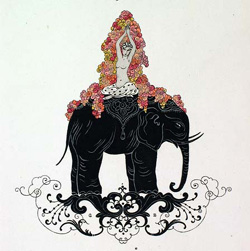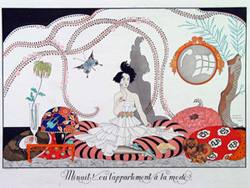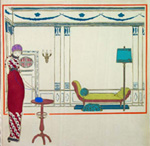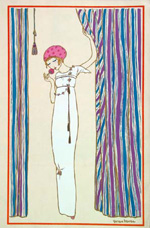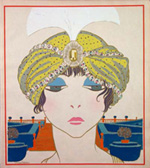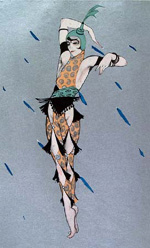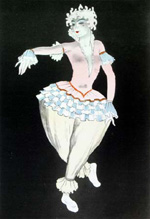 |
||||||
3. The Artful Line: Nouveau to Deco |
Jean Cocteau claimed that “between 1909 and 1929 an explosion of miracles destroyed the old world and made way for the new…An era so rich and so remote that at times it seems to me to belong to the unfathomable domain of Dreams.” Paris in the first quarter of the 20th century was awash in color and line—from the triumph of the serpentine line of Art Nouveau at the Paris Exposition Universelle of 1900 to the geometric renderings of Cubist and Art Deco treatments featured at the Paris Exposition Internationale des Arts Décoratifs et Industriels Modernes of 1925. A stylistic shift in fashion illustration and costume design helped propel the sweeping modernist innovations that occurred in literature, fine arts, and design. Paris was the center for these innovations, a magnet for talented artists and intellectuals from around Europe and the world. Special Collections owns Paul Poiret’s seminal fashion books Les robes de Paul Poiret (1909) and Les choses de Paul Poiret (1911), illustrated by Paul Iribe and Georges Lepape respectively. These illustrations ushered in a modern visual language for fashion by removing traditional depth and shading techniques and replacing them with simple, bold lines and flat expanses of solid color. Vanguard publications fostered the new style of illustration seen in Poiret’s fashion books. Special Collections has a number of these periodicals, such as Lucien Vogel’s La gazette du bon ton (1912-1925), Jacques de Nouvion’s Le journal des dames et des modes (1912-1914) and Pierre Corrard’s Modes et manières d’aujourd’hui (1912-1922). According to Vogel, La Gazette was intended to be “a showcase in which only the most luxurious examples of high fashion and the best of the decorative arts could be displayed, regardless of the cost involved.” Published in limited editions, these periodicals were able to utilize the expensive hand-colored stenciling pochoir technique. Many artists worked in the new style of illustration, including George Barbier, Edouard Garcia Benito, Umberto Brunelleshi, Georges Lepape, Charles Martin, André Edouard Marty, and Gerda Wegener. Their fanciful drawings translated the latest fashions and evoked attitudes of the era. Of particular note is Barbier, who not only created countless fashion plates but also illustrated many “editions de luxe” – books intended to be collectors’ items due to their limited circulation and high standards of printing. In Special Collections are Barbier’s Le bonheur du jour and Fêtes galantes, for which he created highly romantic (and in some cases erotic) images of French life to accompany the poetry of Paul Verlaine. |
|||||
Costume balls and theatrical performances played an important role in
Parisian night-life and were also an important influence on artists and
designers. Especially influential were Serge Diaghilev’s Ballets Russes,
who first performed in Paris in 1909. Léon Bakst designed the exotic sets
and costumes that unleashed a wave of Orientalism. Jacques-Émile Blanche,
an artist and critic, commented that the 1910 premiere of Schéhérazade
“was an important evening for the theatre, for dressmakers, for interior
decorators, for jewelers and for all branches of decoration. It is
difficult today to realize the metamorphosis which transformed the
decorative arts.”
|
||||||
